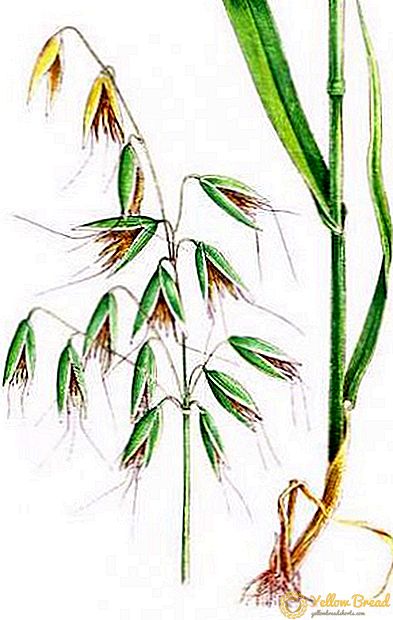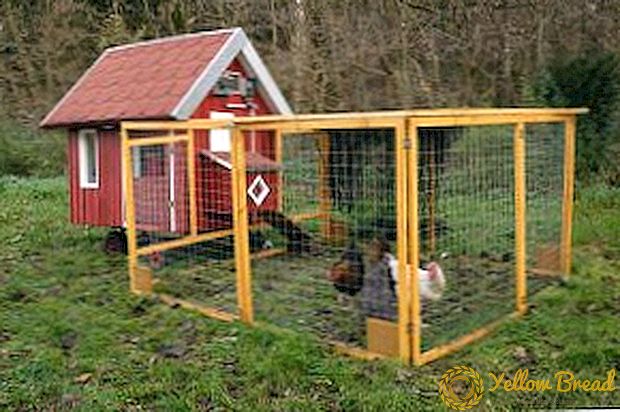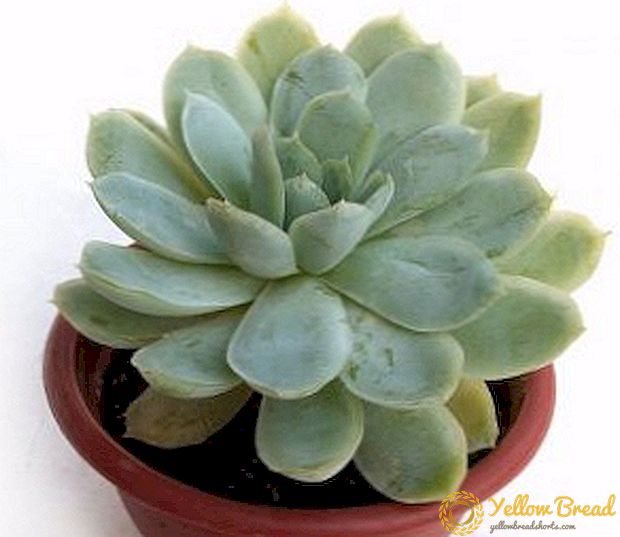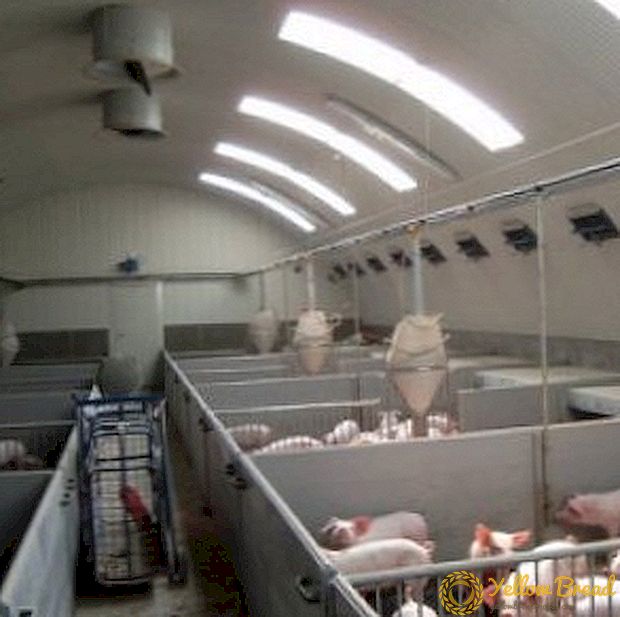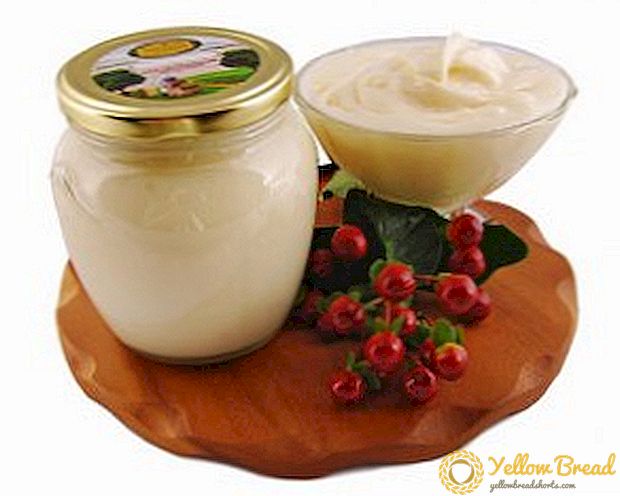 Cherry orchards are very loved in our country. After a long and cold winter so want to try a fresh cherry! And everyone knows that the earliest variety of cherries is “Shpanka”. We will discuss in this article about the cultivation of this wonderful variety, about the proper planting of seedlings and the necessary plant care, which will ensure a good harvest of cherries.
Cherry orchards are very loved in our country. After a long and cold winter so want to try a fresh cherry! And everyone knows that the earliest variety of cherries is “Shpanka”. We will discuss in this article about the cultivation of this wonderful variety, about the proper planting of seedlings and the necessary plant care, which will ensure a good harvest of cherries.
- Description of a grade of cherry "Shpanka"
- Characteristic berries (color, shape, taste)
- The advantages and disadvantages of the variety
- Landing
- Landing time
- A place
- Site preparation
- Landing in the ground
- Tree care
- Watering
- Top dressing
- Whitewash
- Pruning
- Diseases and pests
- Harvesting
Description of a grade of cherry "Shpanka"
Cherry "Shpanka" is a hybrid that is based on the parental forms of cherries and cherries. "Shpanka" has several varieties and is grown in Ukrainian and Moldovan gardens. Variety description indicates the height of an adult plant in 6-9 m, but in the gardens there are old cherry trees above 10 meters. The crown of "Shpanki" is extensive and round. The branches depart from the trunk at an angle of 90 degrees, the length of the adult branch reaches three meters.
Since cherry wood is fragile, with hurricane winds branches can break off from the trunk.
The flowering of the tree begins in the second half of May, the timing of flowering can move in one direction or another - it depends on how warm May is. The cherry blossom is a beautiful sight, the tree seems to be drenched in white and pink.
 When the tree blossoms, the petals fade and fly around, the middle of a cherry flower begins to grow and pour. This is the future berry - cherry.
When the tree blossoms, the petals fade and fly around, the middle of a cherry flower begins to grow and pour. This is the future berry - cherry.The leaves of the plant are smooth, with a dark green color sheet plate, they are attached to the branches with burgundy stalks. The fruits of "Shpanki" ripen in the last days of June or the first decade of July, the young tree begins fruiting from the second to third year of life.

Characteristic berries (color, shape, taste)
- Berry large, average weight up to 45 g.
- It has a light red skin and scarlet juicy flesh.
- Inside the berry there is a round light yellow woody bone.
- The shape of the berries is round, slightly flattened.
- The taste of cherries is sweet, with a light harmonious sourness.
The length of the berry stalk is 5-6 cm.
Fruiting "Shpanki" - an annual.
A tree can fail to harvest only if during the massive flowering of stone trees the weather presented a surprise in the form of frost.
In the case of frosted flowers, the middle (the place of the berry ovary) turns black, and, when they bloom, they do not tie fruit. 
The advantages and disadvantages of the variety
The advantages of the variety include the following:
- can grow on both light and poor and clay soils.Of course, the harvest of berries on poor soil will be less and the quality of the berries will be worse, but the harvest will still be;
- Cherry "Shpanka" - a self-fertile plant;
- quite simple to grow and unpretentious to care;
- the tree freely carries short frosts at -30 ° C, and the frost at -18 ° C is the usual winter temperature for it.
The bark of the tree is not strong, the appearance of cracks and gum flows on the bark is affected by:
- too fast wood growth;
- return spring frosts;
- strong winter frosts.

Landing
Gardeners have to deal with many problems in the process of growing stone fruit. The main reason for the appearance of such problems in the garden is the improper planting of trees, the small distance between them.
Considering the fact that cherries "Shpanki" has a wide and volumetric crown, the space between the trees should be at least 2.5-3 meters.
Landing time
Cherry saplings can be planted both in the spring, and in the fall.
In regions with severe winters, spring planting is preferable, so that the young tree has time to take root and build up a good root system before the onset of frost. The time for spring planting is chosen as soon as the snow melts and the soil in the garden dries out a little.
At this time, the earth is already warm enough, but it still retains enough moisture. This usually occurs in early April.  In areas with a milder climate, cherry seedlings are planted in the fall. A good time for planting young plants comes when the summer heat recedes (the end of September - the whole of October).
In areas with a milder climate, cherry seedlings are planted in the fall. A good time for planting young plants comes when the summer heat recedes (the end of September - the whole of October).
If planting is made at this time, a little more than a month remains before the onset of frost, and this time is enough for the seedling to adapt to new conditions.
A place
To successfully plant the cherries, you need to carefully consider the choice of a place for planting. Stone trees like sunny places that are protected from the wind, so that during the winter frost winds the young seedling does not die out.
When choosing a place, it is necessary to exclude low damp places in which groundwater lies close to the ground surface.The root system of cherries of the variety “Shpanka” is quite branched, its volume is usually almost twice the size of the crown, and the depth of the roots reaches one and a half meters.  If the plant is planted in a swampy area, then with such deep roots it is possible that they come in contact with underground sources of moisture, which will cause their rotting and death of the cherry.
If the plant is planted in a swampy area, then with such deep roots it is possible that they come in contact with underground sources of moisture, which will cause their rotting and death of the cherry.
Cherry does not like shade and penumbra - in such conditions, the growth of the tree slows down, the formation of the crop may not take place at all. In the event that the neighbor of the sapling of the Crammy Hog cherry is a nut, then the distance between these plants should be at least 4-5 meters.

Site preparation
Before you buy cherry seedlings, a gardener needs to think about the place of future planting. The selected place is cleared of weeds and old non-bearing trees and shrubs. After this, a ground marking is made, on which there are places for digging up the landing holes.
Landing in the ground
When laying a cherry orchard you need to take into account all the requirements for the proper planting of this plant:
- the landing pit is 50 cm deep, the width of the pit should be at least one meter;
- the distance in the row between the two landing pits is left in view of the future development of the crown - from 2.5 to 3 m;
- the distance between two rows of cherries is left in view of the future development of an extensive root system - from 3.5 to 5 m;
- a bucket of organic fertilizers (manure, humus, humus) is poured into the finished landing pit and is thoroughly mixed with the soil;
- then 10 liters of water are poured into the landing pit;
- after partial absorption of liquid into the ground, a cherry seedling with neatly straightened horses is installed vertically in a hole;
- the root system of the seedling is filled with soil;
- around the trunk of the planted plant form circular earthen rollers (sides for watering);
- The young tree planted is watered at the root of 10 liters of water.
 In the future, every day a bucket of water pours out under the root of the tree. Such watering will be carried out until the plant takes root in a new place.
In the future, every day a bucket of water pours out under the root of the tree. Such watering will be carried out until the plant takes root in a new place.An indicator that the sapling began, will be the emergence of new side branches or leaves.
Pristvolny circle cherries can be mulched, as mulch you can use compost or three to four years old humus.
For one seedling you need a bucket of compost.
After planting near the trunk of the plant (10-15 cm), a wooden peg is driven into the ground (up to 1 meter high), to which the seedling is tied up. This will save the young plant from breaking in windy weather.

Tree care
In order to get a stable crop of cherries, a gardener needs to take care of the trees:
- loosen the soil and correctly form the crown by pruning;
- time to water, care for the bark;
- process plants from diseases and harmful insects;
- cover mulch soil near pristvolny circles;
- fertilize and ensure the absence of weeds.
Watering
Cherry should be watered in the absence of rain at least once a week, while using 40-50 liters of water per adult plant.
It is necessary to cover the ground over the root layer with mulch - this will reduce the evaporation of moisture from the soil and the need of the plant for watering. 
The periods in which the cherry needs a mandatory daily watering:
- flowering time of the tree (mid May - end of May);
- time of fruit filling (the second decade of June).
If there is no mulch, then it is necessary to carry out a light loosening of the soil near the root layer on a weekly basis - this procedure will also help keep the wet soil from drying out.
A very good solution would be regular watering of the plant in the summer. If the gardener has this opportunity, you can arrange drip irrigation in the cherry orchard.
To correctly calculate the daily dose of moisture for each cherry, you need to take into account that each plant will require 20-30 liters of water. 
Top dressing
In order for the stone fruit to remain stable and annual, the trees need to be fed.
Annual spring dressing. Feeding time - end of March - mid-April. Pristvolny circle cherry cleaned from last year’s leaves and make ammonium nitrate on the surface layer of the soil.
For each square meter of soil, 20-30 g of saltpeter is taken, after which water (2 buckets) is poured over the fertilizer.
Spring feeding for poorly overwintered seedlings. The soil in the vicinity of the circle wheel circle is moistened with liquid fertilizer.Fertilizer is made like this: 20 g of urea is dissolved in one bucket of water. This amount is enough for one plant.
Summer feeding, carried out at the end of fruiting cherries. The plant is watered with a feed mixture consisting of 3 tablespoons of superphosphate and 2 tablespoons of potassium chloride mixed with 10 liters of water.  For every adult tree you need 3.5 buckets of such a liquid mixture.
For every adult tree you need 3.5 buckets of such a liquid mixture.
Autumn feeding for winter cherries. Repeated summer dressing, combined with the introduction of well-decomposed organic matter, in the amount of 0.5 buckets of fertilizer in the root layer of each plant. As organic fertilizers you can take cattle manure, two-year humus, compost, humus.
Fertilization is carried out only after the soil under the plant is cleared of loose foliage and weeds.
Whitewash
The bark of young cherries (under the age of three) should be protected from sunburn. For this, in early spring, the trunk and lower thick branches of the cherry are dressed in a white paper case. This "sunscreen" cover can be made from a roll of old wallpaper.
The trunks of adult fruit trees every spring lime. For many people, whitewashed and elegant trees are a sign of the onset of spring and fast Easter.  But whitewashing trunks is not for decoration, it protects plants from harmful insects, sunburn and disease.
But whitewashing trunks is not for decoration, it protects plants from harmful insects, sunburn and disease.
To whitewash the stems, it is not enough one lime, you need to add and mix some more useful ingredients into the solution:
- 10 liters of water;
- 3 kg of lime-fluff;
- 1 kg of fresh cow dung;
- 1.5 kg of clay;
- Grated 100g bar of laundry soap.
Pruning
Cherry "Shpanka" - a tree with a bouquet type of fruiting and tying berries on the annual shoots. To fructification was constant, it is necessary to conduct an annual spring pruning of the plant.
 The best time to perform this procedure is early spring, before swollen buds begin to grow.
The best time to perform this procedure is early spring, before swollen buds begin to grow.What do the annual pruning give:
- neatly shaped crown plants;
- do not allow the tree to grow over with branches (thicken the crown);
- pruning contributes to the fact that the berries grow larger;
- increase in total yield;
- after pruning, the plant grows many young fruit branches.
- in the year of planting Seedling plants are pruned, leaving only 5-6 branches. These are the skeletal branches of the plant, the approximate distance between them is 10-15 cm. The rest of the young growth is cut by the shears;
- in the second year of life plants need to cut the branches that grow inside the tree crown. Excessively grown skeletal branches are shortened a little, the plant should grow more in breadth, but not in height. The pruning is aimed at general shaping and so that the crown is not thickened with unnecessary branches;
- in subsequent years such pruning should be done every spring. At old, ten-year-old trees during pruning, dried, inanimate branches are removed.Thus, the old cherry is rejuvenated, and the period of its fruiting is extended for another few years.

If the resulting composition is too liquid - it can be slightly thickened by adding wood ash. To make the solution more liquid, you can use any vegetable oils.
Diseases and pests
Cherry "Shpanka" is affected by fungal diseases such as coccomycosis, moniliosis, anthracnose.
Cherry coccomycosis it appears in red spots on a green leaf blade, white and pink plaque of mushroom spores on the lower part of the leaf and deformed, unsuitable for eating berries. Leaves affected by the disease are showered from the plant during the summer months.  One of the consequences of coccomicosis is that the tree goes into the winter sick, weak, and this can lead to his death.The harmful fungus overwinters in fallen leaves.
One of the consequences of coccomicosis is that the tree goes into the winter sick, weak, and this can lead to his death.The harmful fungus overwinters in fallen leaves.
Measures for prevention of coccomycosis:
- treatment in spring Bordeaux mixture of young leaves;
- at the end of flowering, the garden is treated with the Topsin-M or Skor preparations;
- removal from the site or destruction by fire of fallen leaves.
Moniliosis of the cherry (second name - monilial burn) - Fungal disease, apparently manifested in as if "baked" branches and leaves. Launched monilioz causes gray growths on the bark of the tree and berries, after which some of the fruits rot and fall off.
The remaining berries on the branches dry up (mummified). The bark infected with fungus is covered with cracks and gum drips, which leads to the gradual death of the plant. 
How to deal with moniliosis cherries:
- to process the Bordeaux mixture or a 3% solution of iron sulphate with freshly bloomed leaves;
- spray trees with fungicides or 1% Bordeaux mixture immediately after flowering;
- remove (burn) all infected (fallen and left on the tree) berries and leaves. Sick branches are cut with the capture of up to 10-12 cm of healthy wood.
Harvesting
"Shpanka" begins to ripen in the third decade of June. In cold summer, the beginning of the ripening of the harvest can be transferred to the first decade of July. Green berries begin to become blush, blush.  In full ripeness cherry becomes bright red, with juicy scarlet flesh.
In full ripeness cherry becomes bright red, with juicy scarlet flesh.
The taste of berries is sweet with a slight sourness. Ripening, the berries are easily separated from the stalk, and if the gardener is late with the harvest, they can crumble to the foot of the tree.
Cherry "Shpanka" - the earliest ripening variety. Other types of cherries start ripening two weeks later, "Pile".
Cherry of this variety is used for making compote, preserves, jam, confiture, jelly, mousses, berry liqueurs, liqueurs and wines. Mistresses lay fresh cherry berries in freezers for winter consumption.In electric dryers prepare dried and dried cherries
Cherry orchards, grown with love and perseverance, for many years will generously give the gardener abundant crops, excellent white-boiled spring bloom and scattered shadow, saving from the summer heat.


